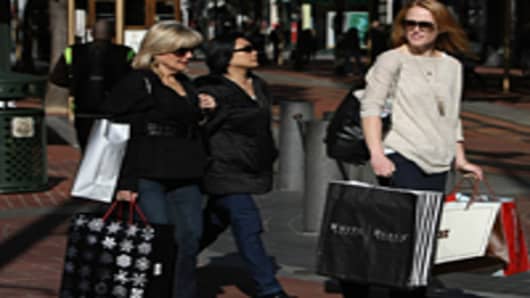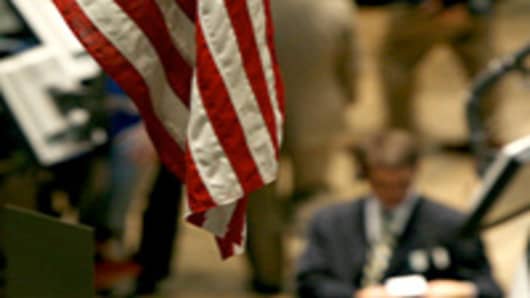Now that the March jobs report is out of the way, investors will be looking for the next points of focus and a big one will be the consumer.
Friday's employment report showed the creation of 162,000 jobs, somewhat less than the expected 200,000 and way below some of the most optimistic forecasts.
Yet, the dollar and stock futures held firm in a holiday session Friday, and the yield on the 10-year Treasury edged closer to 4 percent as markets greeted the report as more positive than negative.
Economists were surprised that private sector hiring outpaced government hiring by better than two-to-one. There was also an upward revision to earlier data, resulting in a cumulative 62,000 more jobs in January and February.
"I think the best way to think about it is the February data was terribly skewed by the bad weather. If you put them both together, you get what I think is the trend for private sector job growth of 50,000 to 100,000," said Marc Chandler, chief currency strategist at Brown Brothers Harriman.
The government's temporary hiring of Census workers in March resulted in 48,000 jobs, well below the more than 100,000 expected.
The improvement in the jobs data—the best in three years—is a tiny step forward.
The report showed no improvement in the unemployment rate of 9.7 percent and the amount of the underemployed continued to edge up.
But because jobs are such a major component of the recovery picture and key to the comfort level of consumers, investors will now be looking for confirmation of improvement in other employment measures and consumer-related data.
In the week ahead, Monday's ISM nonmanufacturing report will show whether there is any pickup in service-sector hirings, and chain store sales data Thursday will detail what the consumer was willing to spend on in the month of March.
Fed Ahead
Bond traders Friday said there was a swirl of speculation that the Fed would raise the discount rate when it holds a regularly scheduled, bimonthly board meeting Monday.
The Fed surprised markets in February when it hiked the discount rate by a quarter point to 0.75. Now a tense Treasury market is looking for another quarter point. The discount rate is the Fed's emergency lending rate for banks and does not affect consumer loans or mortgages.
"I think they are thinking more strategically and acting more tactically than people are giving them credit for," said Kevin Ferry of Cronus Futures.
Ferry said the short end of the Treasury market would be helped by a hike, and it would lead to a flatter Treasury curve. A side effect might also be smoother bond auctions as the markets digest a massive, $165 billion in Treasury supply in the coming week.
"It behooves the Fed to go ahead and move symbolically to show they're tightening up," he said.
But J.P. Morgan economist Michael Feroli dismissed the speculation, saying the Fed's very announcement of the meeting seems to have caused the chatter in what was a thinly populated market Friday.
He said, in a note, that when the Fed did raise the discount rate, it did so after holding a non-regular meeting.
Feroli wrote that it's certainly possible the Fed could raise the discount rate, but the market misinterpreted a similar announcement two years ago.
Fed minutes from the last FOMC meeting are released Tuesday afternoon, and they will certainly get a lot of attention as traders attempt to handicap the Fed's next steps in unwinding its emergency measures. The Fed ended its mortgage purchase program March 31.
There's also a parade of Fed speakers in the week ahead, starting with Fed Chairman Ben Bernanke, who has two appearances.
Bernanke discusses economic challenges Wednesday at 1:30 p.m. New York time, before the Dallas Regional Chamber. He also speaks Thursday evening in Washington on economic policy lessons.
The spotlight will also turn to Wall Street, the housing crisis and regulators in the coming week as the Financial Crisis Inquiry Commission holds a series of hearings Wednesday through Friday, featuring former Fed Chairman Alan Greenspan, former Citigroup CEO Chuck Prince, former Citigroup executive and Treasury Secretary Robert Rubin, and former Fannie Mae CEO Daniel Mudd.
Currency Manipulator?
A positive for global markets could be the seeming cooling of tensions between the U.S. and China.
President Obama spoke with President Hu Jintaofor an hour Thursday night on a range of topics. Hu will also attend a nuclear security summit in Washington this month.
"Averting a trade war with China is a good thing..I wouldn't buy the dollar on it, but it is probably supportive in general," said Chandler.
He said it is now less likely the U.S. Treasury will label China a currency manipulator, despite the urging of some members of Congress.
Chandler said China's agreement to support U.N. efforts to curb Iran's nuclear program was also a sign that the relationship between the U.S. and China is becoming less tense.
Treasury Secretary Tim Geithner Friday said he is confident that China will decide that it is in its interest to let its currency float.
Members of Congress and others have criticized China's peg to the dollar, which keeps the currency weak and gives China a trade advantage.
Consumer Crawling Back?
Most of the data in the coming week is in some way tied to the consumer.
Pending home sales are reported Monday; consumer credit is Wednesday; weekly jobless claims are Thursday and wholesale trade is reported Friday.
"Consumer spending has come back better-than-expected but you could not expect it to continue that way if jobs didn't come back.
Now how strong is the consumer rebound going to be? I'd rather argue about that than whether we were going to have one," said Bill Stone, chief investment strategist at PNC Wealth Management.
Economists were encouraged by the surprising strength in Thursday's March auto sales, which jumped 24 percent.
The rebound was driven by heavy financial and other incentives.
Citigroup chief economist Robert DiClemente said the gains in auto sales could also be a sign of better credit availability for consumers.
"Fundamentally, labor market conditions are improving and many industries already have shown renewed gains in headcount.
Most important, at recovery's core the latest data on consumer spending have reinforced our judgment that the upturn is very near a threshold of self-sustaining momentum," he wrote in a report.
DiClemente said consumer spending has been on a slow and steady rise since the middle of last year, when it stabilized with the help of government support.
The pattern of gains, however, was muddied by the bump in car buying in the cash for clunkers program last summer.
He said when autos are moved from the data, there is a more robust underlying picture.
"Stripping out autos from the spending data reveals not only a steady stream of gains but an accelerating one with outlays rising about 1-1/2 percent last summer, roughly 2-1/2 in the fall, and now easily above 3 percent," he wrote.
Stone said he sees three pieces of the economic picture that are key for the rising stock market.
"Getting the payrolls up helps those pieces stay in place. The pieces are housing, consumer spending and employment. If you finally get employment it helps reinforce the housing and the consumer spending. It becomes a self sustaining recovery," said Stone.
The lack of a housing rebound though is worrisome to Stone.
"You've still got to say to yourself, you have to keep an eye on housing. Those numbers have been pretty hideous when you talk about new and existing home sales," he said.
Whither Markets?
Whither Markets?
The Dow in the past week gained 0.7 percent to 10,927, a short hop to 11,000. The S&P 500 rose by nearly a percent to 1,178.
The dollar index lost a percent in the past week, but the dollar was up more than a percent against the euro, at $1.3478.
In Friday's shortened bond session, the high yield on the 10-year reached 3.948 and it was trading at 3.939 percent at the close.
Ferry said it's very possible the psychological 4 percent level on the 10-year could be breached this week.
The Treasury auctions $8 billion in 10-year TIPS Monday; $40 billion in 3-year notes Tuesday; $21 billion in reopened 10-year notes, and $13 billion in 30-year reopened bonds. Additionally, there is more than $80 billion in T-bills.
Oil jumped over $85 per barrel in the past week, and some traders expect its upward momentum to continue for now though it may sell off initially Monday. It closed the week 6 percent higher at $84.87, its best settle since Oct. 9, 2008.
John Kilduff, a partner with Roundearth Capital, said he believes oil could see $100 per barrel by the summer.
He said its move in the past week was driven by high expectations for the March jobs report.
"Oil just jumped on board that freight train. It's the good auto sales. Good news out of China, the mandate out of China. There's lot going for r it," he said.
But he said the oil market was pricing in very high expectations for the March jobs report and it could see selling when it reopens.
Oil resumes trading in the electronic session Sunday night.
"Part of the problem is everybody's gotten so bearish on it, it was almost a foregone conclusion that it would reverse for awhile," he said.
Kilduff said the move to $100 would be brief.
"The demand has been coming back. The China numbers are being validated, much to skeptics' dismay and also the U.S. refining industry continues to idle their capacity. OPEC is being stingy with oil. The whole system is being caught short a little," said Kilduff.
However, if oil moves above $90, he expects OPEC to flood the system to prevent prices from rising too much, which would threaten the economic recovery but also chill demand.
Fed Ahead Besides Bernanke's appearances, Fed Vice Chairman Donald Kohn speaks in San Francisco Thursday at 4 p.m. on the economic outlook.
St. Louis Fed President James Bullard speaks Monday in New York.
New York Fed President William Dudley speaks Wednesday at the Economic Club of New York and then on Thursday in Lexington, Va.
Kansas City Fed President Thomas Hoenig speaks Wednesday in Santa Fe.
Minneapolis Fed President Narayana Kocherlakota speaks Tuesday in Minnesota and Thursday in Montana.
Questions? Comments? Email us at marketinsider@cnbc.com





